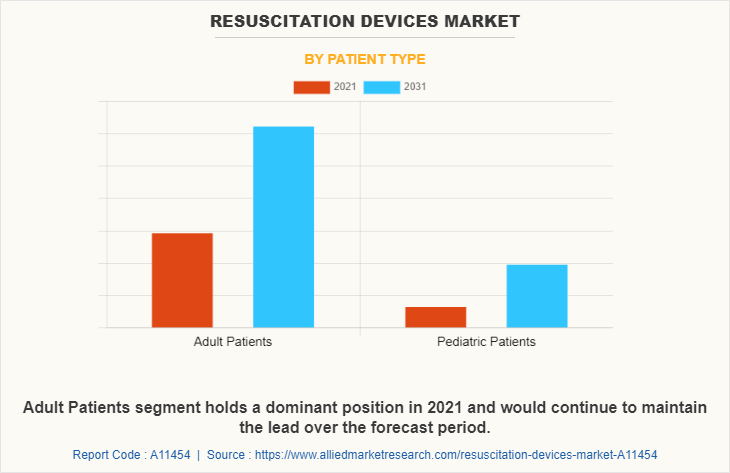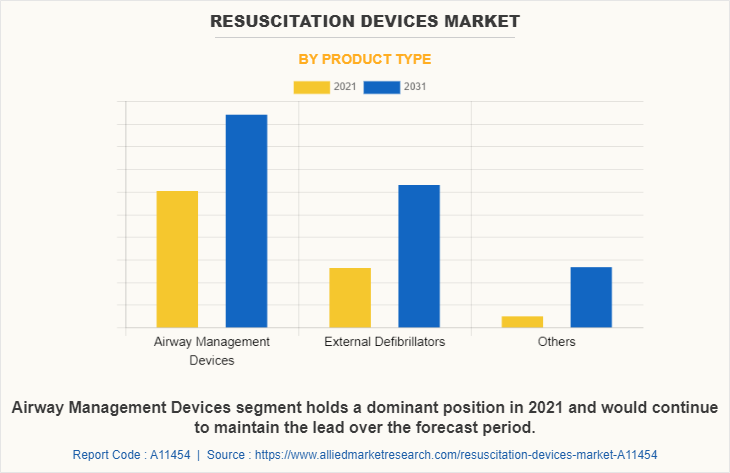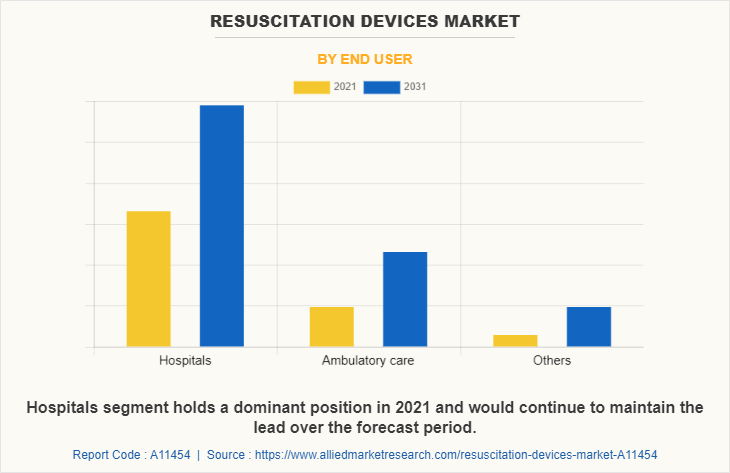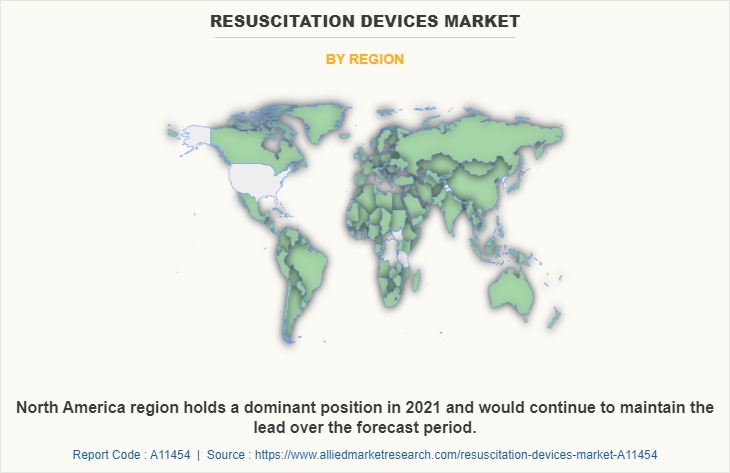Resuscitation Devices Market Size & Trends
The global resuscitation devices market size was valued at $7.6 billion in 2021, and is projected to reach $12.2 billion by 2031, growing at a CAGR of 4.8% from 2022 to 2031. The resuscitation device uses positive pressure to inflate the lungs of a person unable to breathe on their own to keep them oxygenated and alive. These devices are used infrequently and there is much to be considered for selecting items that are both easy to use and maintain. The staff must know where to find equipment at the time it is needed and training in its use must be undertaken to a level appropriate to the individual's expected role. The resuscitation device can be used in an attempt to restart the heart and breathing and restore their circulation. The cardiopulmonary resuscitation is invasive, involving chest compressions device, delivery of electric shocks from a defibrillator, injection of drugs, and ventilation of the lungs. If performed promptly, the cardiopulmonary resuscitation has a good success rate in some circumstances.

Historical overview
The market was analyzed qualitatively and quantitatively from 2022-2031. The resuscitation devices market grew at a CAGR of around 4.8% during 2022-2031. Most of the growth during this period was derived from the North America owing to the improving health awareness, rising incidences of cardiac arrest, as well as well-established presence of domestic market players in the region.
Key Market Dynamics
Growth & innovations in the medical device industry for the manufacturing of resuscitation devices owing to massive pool of respiratory and cardiac conditions incidences that creates an opportunity for the Resuscitation Devices Industry. Rise in launch of new products made up of advanced technology by various key players across the globe is set to affect the Resuscitation Devices Market Growth positively. For instance, in September 2020, Royal Philips announced the launch of the HeartStart Intrepid monitor/defibrillator with IntelliSpace Connect. It was created to provide clinical and operational efficiencies at every stage of the emergency care continuum. The solution lets caregivers evaluate and treat patients during the most demanding medical emergencies in both pre-hospital and hospital settings. The growth of the Resuscitation Devices Market Size is expected to be driven by high potential in untapped, emerging markets, due to availability of improved healthcare infrastructure, increase in unmet healthcare needs, and surge in demand for resuscitation devices. Furthermore, the healthcare industry in emerging economies is developing at a significant rate, owing to rise in demand for enhanced healthcare services, significant investments by government to improve healthcare services, and development of the medical devices industry in emerging countries. E-commerce (electronic commerce) has become a vital tool for small and large businesses globally, due to rise in preference of consumers for online shopping over traditional purchasing methods. This is attributed to further creates Resuscitation Devices Market Opportunity. The demand for resuscitation devices is not only limited to developed countries but is also being witnessed in the developing countries, such as China, Brazil, and India, which fuel the growth of the market. Factors such as rise in adoption of respiratory testing kits, and increase in awareness towards resuscitation procedures through the devices, further drive the growth of the market. Furthermore, rise in consumer awareness related to preventive healthcare and ease of accessibility boost the adoption of resuscitation devices. Moreover, increase in promotional activities by manufacturers and growth in awareness for respiratory testing kits among the general population are expected to fuel their adoption in the near future.
Though the stringent regulations for the approval of resuscitation devices and lack of awareness in developing economies about their different applications are creating an enormous downfall in the market growth. For instance, according to the article by The New Indian Express, in July 2021, among the total population of India, less than 2% people were aware of cardiopulmonary resuscitation. This was the major issue as India is less in training the public for cardiopulmonary resuscitation and also the India does not have robust emergency medical system and ambulances also cannot reach in first three to five minutes. All it leads to is one major drawback for demand for the adoption of resuscitation devices. Moreover, the unfavorable regulatory scenarios of the products used for testing is anticipated to hamper the growth of the Resuscitation Devices Market Size.
The COVID-19 pandemic affected the Resuscitation Devices Industry in a negative way, like various other medical devices industries were affected. COVID-19 severely impacted the overall medical devices market, with different segments of the industry experiencing wide-ranging effects. It affected in the volume decline of medical devices segment and supply chain constraints with unusual PPE supply and demand dynamics in the medical devices. These conditions continued to create various financial impacts to the manufacturing operations by necessitating precautions for personnel to operate safely both in person as well as remotely. The COVID-19 pandemic has also heightened other risks, including risks associated with competitive pressures, supplier relationships, international operations, regulatory and licensing, changes to the U.S. healthcare environment, cyber security, and access to capital market. Moreover, the COVID-19 pandemic has impacted global economies, resulting in workforce and travel restrictions, supply chain and production disruptions and reduced demand and spending across many sectors. Furthermore, the market players experienced operational challenges in the need to protect employee health and safety, site shutdowns, workplace disruptions and restrictions on the movement of people, raw materials and good, that could materially adversely impact the business, results of operations and overall financial performance of the companies. However, according to the data by American Society of Anesthesiologists, the tracheal intubation for patients with COVID-19 is required for invasive mechanical ventilation. As with many other practices during the pandemic, airway management strategies may have changed rapidly during this period despite the paucity of strong evidence. Recommendations were published early on in the pandemic by expert clinicians to guide professionals on tracheal intubation practices to maximize patient and healthcare worker safety. This made the demand for airway management devices to increase in the COVID-19 pandemic.
Market Segmentation
The resuscitation devices market is segmented based on product type, patient type, end user and region. On the basis of product type, the market is divided into airway management devices, external defibrillators and others. On the basis of patient type, the market is classified into adult patients, and pediatric patients. On the basis of end user, the market is categorized into hospitals, ambulatory care and others. Region wise, the market is studied across North America (the U.S., Canada, and Mexico), Europe (Germany, France, UK, Italy, Spain, and Rest of Europe), Asia-Pacific (Japan, China, Australia, India, South Korea and rest of Asia-Pacific), and LAMEA (Brazil, South Africa, Saudi Arabia, and rest of LAMEA).

The adult patients segment dominated the global market in 2021, and is anticipated to continue this trend during the Resuscitation Devices Market Forecast period. This is attributed to increase in application of resuscitation devices by the adult population.

The airway management devices segment dominated the global Resuscitation Devices Market Share in 2021, and is expected to remain dominant throughout the forecast period, owing to increase in adoption of airway management devices for various ventilation management of ill patients and availability of resuscitation devices in the market by various key players.

The hospitals segment held the largest market Resuscitation Devices Market Share in 2021, and is expected to remain dominant throughout the forecast period, owing to hospitals and ambulatory care centers that are the oldest and most conventional medium for using resuscitation devices to manage the critically ill patients, and ease of the availability of these services in the hospitals.

Regional/Country Market Outlook
North America was the dominant region and is expected to remain dominant throughout the forecast period, owing to high prevalence rate of heart attack, increase in the number market players and surge in the number of products available in the region. However, Asia-Pacific is expected to witness the highest CAGR during the analysis period, owing to the presence of high populace countries such as India and China, which in turn increases the prevalence rate of heart diseases, and the increasing number of strategies and trends adopted by the market players.
Key Benefits for Stakeholders
- This report provides a quantitative analysis of the market segments, current trends, estimations, and dynamics of the resuscitation devices market analysis from 2021 to 2031 to identify the prevailing resuscitation devices market opportunities.
- The market research is offered along with information related to key drivers, restraints, and opportunities.
- Porter's five forces analysis highlights the potency of buyers and suppliers to enable stakeholders make profit-oriented business decisions and strengthen their supplier-buyer network.
- In-depth analysis of the resuscitation devices market segmentation assists to determine the prevailing market opportunities.
- Major countries in each region are mapped according to their revenue contribution to the global market.
- Market player positioning facilitates benchmarking and provides a clear understanding of the present position of the market players.
- The report includes the analysis of the regional as well as global resuscitation devices market trends, key players, market segments, application areas, and market growth strategies.
Resuscitation Devices Market Report Highlights
| Aspects | Details |
| Market Size By 2031 | USD 12.2 billion |
| Growth Rate | CAGR of 4.8% |
| Forecast period | 2021 - 2031 |
| Report Pages | 220 |
| By Patient type |
|
| By Product type |
|
| By End User |
|
| By Region |
|
| Key Market Players | Cardinal Health Inc., ASAHI KASEI CORP, Koninklijke Philips N.V., Vyaire Medical, Teleflex Incorporated, ICU Medical Inc., Drgerwerk AG, Nihon Kohden Corporation, Ambu A/S, Stryker Corporation |
Analyst Review
The resuscitation devices are widely used in the hospitals, pre-hospital settings, emergency care and community settings. The demand for the resuscitation devices can be seen to be increased due to the rise in the prevalence of cardiovascular diseases associated with aging, smoking, pollution, usage of tobacco, avoidance of physical activity, unhealth eating lifestyle. These are further supported with the incidences like raised blood pressure, blood glucose, blood lipids and obesity. The growth in the demand from hospitals and other healthcare facilities for the resuscitation devices are gaining significant rise worldwide owing to the benefits offered by the devices in maintaining the breathing and circulation in the patients in the healthcare organization.
Asia-Pacific is expected to witness the highest CAGR during the analysis period, owing to the presence of high populace countries such as India and China, which in turn increases the prevalence rate of cardiovascular diseases, increase in awareness about cardiopulmonary resuscitation of the patient in cardiac arrest conditions and increase in government expenditure on healthcare and other related trends adopted by the market players.
The total market value of the resuscitation devices market is $7550.34 million in 2021.
The forecast period in the report is from 2022 to 2031.
North America is the largest regional market for Resuscitation Devices.
The market value of the resuscitation devices market in 2022 was $7958.06 million.
The top companies that hold the market share in the resuscitation devices market are Ambu A/S, Asahi Kasei Corp, Cardinal Health Inc. , Drägerwerk ag, ICU Medical Inc., Koninklijke Philips N.V., Nihon Kohden Corporation, Stryker Corporation, Teleflex Incorporated, Vyaire Medical.
The base year for the report is 2021.
Yes, resuscitation devices companies are profiled in the report
The key trends in the resuscitation devices market are an increase in awareness about emergency care, government regulation and a surge in technological advancement in resuscitation devices.
Loading Table Of Content...



